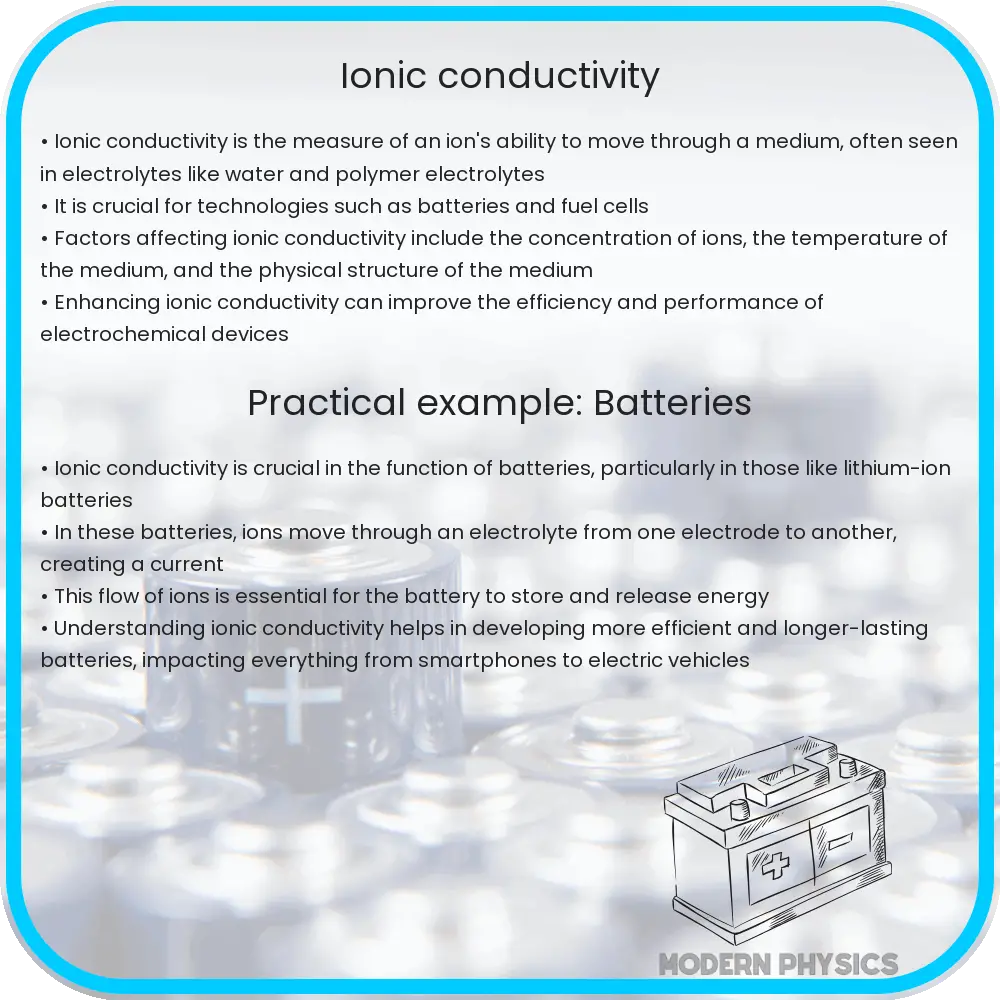Ionic conductivity is the movement of ions through a medium under an external electric field, crucial for developing materials like batteries and sensors.

Introduction to Ionic Conductivity
Ionic conductivity refers to the movement of ions through a medium such as a liquid or solid under the influence of an external electric field. In materials science, understanding and controlling ionic conductivity is crucial for the development of various advanced materials, including batteries, fuel cells, and sensors. In this article, we will explore recent advances in the field, examine the innovative techniques used to measure and analyze ionic conductivity, and delve into the practical applications of these materials.
Advances in Ionic Conductivity
Recent years have witnessed significant advancements in the field of ionic conductivity, particularly in enhancing the performance and efficiency of electrolytes and ionic conductors. These advancements are largely driven by the needs of energy storage and conversion technologies, which rely heavily on high-performance materials. For example, solid electrolytes in batteries have been developed to replace liquid counterparts, providing greater safety and higher energy densities.
One major breakthrough has been the development of superionic conductors, which exhibit exceptionally high ionic conductivity. These materials, such as lithium-rich anti-perovskites, have opened up new possibilities for battery technologies, potentially increasing the speed of charging and enhancing the lifespan of batteries.
Techniques for Measuring Ionic Conductivity
To investigate and optimize ionic conductors, researchers employ a variety of techniques that allow them to measure the movement and behavior of ions within materials. Common methods include:
- Electrochemical Impedance Spectroscopy (EIS): This technique uses a small AC voltage to the material and measures the response, allowing scientists to determine resistance and, hence, conductivity.
- Four-point Probe Method: This method typically involves applying a known current through outer probes and measuring the potential drop using inner probes, facilitating direct conductivity measurements.
- Nuclear Magnetic Resonance (NMR) Spectroscopy: NMR can be used to visualize and measure the dynamics of ion movement, providing insight into the mechanisms underlying ionic transport.
In addition to these, emerging techniques such as laser-induced breakdown spectroscopy (LIBS) and Raman spectroscopy are gaining traction for analyzing the structural and chemical composition of ionic conductors. These techniques contribute significantly to the understanding of how ionic conduction occurs and how it can be improved.
Applications of Ionic Conductive Materials
The improved understanding and control of ionic conductivity have wide-ranging applications in several key industries. Among these, energy technology stands out as a field that greatly benefits from enhanced ionic conductors. Ionic conductive materials are essential components in:
- Batteries: Used mainly in lithium-ion batteries, ionic conductors influence the charging rates and energy densities.
- Fuel Cells: They play a critical role in electrolyte membranes, facilitating ion transport while preventing the mixing of reactants.
- Sensors: Ionic conductors can be used in the detection mechanisms of chemical and biological sensors.
Furthermore, advancements in ionic conductivity are paving the way for innovative uses in areas such as smart textiles and medical devices, where flexible and efficient energy storage and conversion are crucial.
Challenges and Future Directions in Ionic Conductivity
Despite the promising developments in ionic conductivity, there are still significant challenges that need to be addressed. One of the main issues is the stability of high-performance ionic conductors under real-world operating conditions. For instance, many superionic conductors are sensitive to moisture or CO2, which can degrade their performance over time.
Another challenge is the scalability of the production of these advanced materials. While they show exceptional properties in the lab, manufacturing them on an industrial scale at a reasonable cost remains a hurdle. Researchers are actively working on developing more robust and cost-effective materials and production methods.
Looking to the future, there is a strong push towards environmentally friendly and sustainable ionic conductors. This includes research into ionic liquids and polymer electrolytes that are less harmful to the environment and can be produced from renewable resources.
Conclusion
In conclusion, the field of ionic conductivity continues to be a vibrant area of research with substantial potential for technological innovation. The advancements in materials and measurement techniques have already begun to transform industries such as energy storage, electronics, and medical technology. However, the journey is not without its challenges. Overcoming issues related to material stability, production scalability, and environmental impact will be crucial for the future development of this field.
As we move forward, it will be essential to continue investment in research and development to unlock the full potential of ionic conductive materials. The collaborative efforts of scientists, engineers, and industry stakeholders will be key in overcoming existing barriers and paving the way for new applications that could revolutionize how we use and store energy. By pushing the boundaries of what is possible with ionic conductivity, we can anticipate more efficient, safer, and environmentally friendly technologies emerging in the near future.
